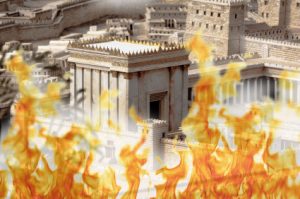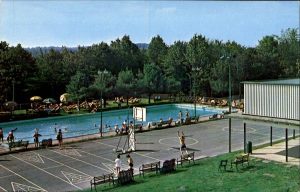Voeschanan 2020 – The Twenty Commandments
by devadmin | July 30, 2020 3:16 pm
Several weeks ago, we opened with a plug for the Jewish Lego Masters organized by Rabbi JJ Duchman and the Oisvorfer’s givaldige daughter Alex Grossman. We’re back today with a link to the finale. Click below to enjoy this 40 minute inspiring Tishe Be’ov themed finale episode and see who is declared the winner. We have yet to merit the rebuilding of Bayis Shlishi (3rd and final Temple) but in Lego-world, all is possible. 
Twenty? OMG! Those who have been skipping shul for whatever reason – too hot to leave the house, the mask is uncomfortable, it’s summer time, and or, I already heard the Torah and Sefer Devorim is but a repeat of the other heylige books, this week’s parsha of Voeschanan contains a second presentation of the Aseres Hadibrois (the Ten Commandments). Ober, if all that’s emes and avada it is, why would the Ois title this review “The Twenty Commandments?” Do we mamish have twenty? Didn’t Moishe come down with ten? He did! Has the heylige Ois gone off the reservation? Nu, so a few rabbis would like to think, ober it’s grada not emes. All that for another week –in the very near future- ober this week, with Tisha Be’ov just about in our rear view mirrors and ‘Shabbis Nachmu’ with great memories of our single days in the Pioneer, Pine View, Grossingers, the Homowack, the Concord, and even Howard Johnson’s –alayhem hasholom- (may they all rest in peace), this week we shall take a shtikel look at a concept that’s been on my mind ever since I entered the yeshiva system where they taught us azoy: there are no extra words in the heylige Toirah. Each and every word and even letter, is there for a reason. One more time: since there are no unnecessary words in the heylige Toirah, words that appear extra, must be there in order to teach some detail that we would not have known otherwise. And by that logic, though we have already read about the Aseres Hadibrois back in Sefer Shmois, there are good reasons for their second appearance. Veyter.
Shoin, as kids and even as teens, who was going to argue this concept; we didn’t necessarily chap it but we plowed further; we just believed. Moreover, we had no choice; the rebbe so stated and it was fact. Back then many yeshiva rebbes (Holocaust survivors, most of them) knew discipline only the way they themselves mistama experienced it; with a patch in-punim- (slap to the face, typically more than one), and also with the sting of the shtekin (stick) employed when being a michutzif (wisenheimer) by asking questions they didn’t like. Taka, many a rebbe used these tactics as their weapon of choice to quiet dissent, curb bad behavior, or when we asked uncomfortable questions. The result: we were afraid to ask; we may not have chapped the concept but we did chap petch! Wisenheimers had welts to prove they were inquisitive. Ober as we get older and make our way through the parshas, we find many subjects, themes, and words repeated, at times verbatim, and at other times with slight twists. What’s taka pshat? How can something be repeated and not at the same time?
These questions are grada timely because Parshas Vo’eschanan -which as an aside marks the beginning of year 11 of Oisvorfer posts, contains -as mentioned in the opening paragraph- another set of Ten Commandments, a full set mamish. In fact, the second set is perhaps even more explicit. Let’s also recall that Moishe shattered the first set when he came down the mountain only to find the Yiddin reveling around a golden calf, a sin the RBSO has never fully forgiven. Avada we assume that the replacement Commandments were an exact copy -word for word- of the first, ober do we know with certainty? We do not. What we know is that the RBSO sent Moishe down with a replacement set. It is shayich (plausible) that what Moishe was carrying was mamish the same, and it’s also shayich that there were variances. In other words: is it the case that the second presentation of the Ten Commandments – the ones we read this shabbis- contain the exact wording as did the first set, the one’s he broke? Or, do they more resemble the replacement set he came down with? And if they do contain the same words, are these words then not being repeated? If they are the same, why are they repeated? And the answers? Ver veyst; ober thinking and asking these questions does not render one a heathen or worse.
All that being said, asks the Oisvorfer azoy: do we taka have 20 Commandments? Is pshat that nothing is repeated in the heylige Toirah and therefore, if it’s reduced to writing one more time, and given that the RBSO allowed for these words to appear again in this week’s parsha, that we taka have 20 (though they look eerily similar to the first ten)? Or, is pshat that we only have ten and there must be some valid reason why Moishe repeated them again -albeit with a few differences? All that being said, and if words and concepts are in fact repeated, why not just say so? What’s taka pshat? If the RBSO thought to remind us multiple times to remember that we were slaves in Mitzrayim, avada that is important to Him and is therefore repeated. And while the Ten Commandments make only two appearances, the concepts contained therein –the violation of the heylige shabbis by way of example, instructions to remember the heylige shabbis, and many others, appear several times elsewhere in the heylige Toirah. And if the heylige shabbis is a key to our religion –we rest because He rested on the seventh day- and therefore we hear about shabbis multiple times in the heylige Toirah, what’s so giferlich about denying that words are repeated? And if that’s the case, why did our rebbes -relying avada on the writings of others- tell us that the heylige Toirah contains not even one extra word or letter? What taka do our sages tell us? And the answers? Though the heylige Oisvorfer has been studying the heylige Toirah for most of his life, he has yet to hear an answer that fully satisfies. That being said, let’s find out what our sages had to say.
Says the Ramban on his commentary to Sefer Hamitzvos: there is not even one extra letter in the Toirah. To quote (almost verbatim), he says azoy: “For the Torah scroll of G-d is perfect, it has neither a superfluous nor a missing letter, they were all written with wisdom.” Case closed? Says Rabbenu Bachye (commentary to Bereishis (47: 28, azoy):
אבל התורה כולה רמזים, אין בה תיבה ואות שלא נאמר לענין הכרחי ומוצרך
In English: “The Torah is all hints; it has no word or letter that was not stated for necessary reason.” And says the RambaN (commentary to Shmois (20:20): אין כפל במקרא – again in English: There is no repetition/superfluity in the Torah. And says R. Yaakov Emden (as translated by R. Dr. J.J. Shachter’s in Jacob Emden: Life and Major Works p. 282.) in his commentary to Ashrei, azoy: It is true that those who interpret Scripture literally are incapable of explaining the nature and the reason for the repetition of meliẓah in Scripture in so many different forms. Verily, the initiated will understand that it is not without significance and it is not by chance that there is a multitude of synonyms for the same matter and changes in language and terminology (meliẓah).”
Let’s introduce a shtikel machloikes (argument) between R’ Akiva and R’ Yishmael as brought down in the heylige Gemora (Soitah 3A): R’ Yishmael says that sometimes things are unnecessarily repeated because of the one new thing the passage is coming to teach us. Grada this makes good sense. R’ Akiva disagrees and says that we can even learn something out from the repetition. Exactly what that means, ver veyst, ober according to R’ Yishmael while the words themselves may not be teaching us something new, they are not unnecessary, since they provide context. On the other hand and assuming that taka every letter is meaningful, it isn’t zicher that we humanoids possess a Toirah that it is identical letter for letter with the original. Let’s recall that it was written by Moishe who was an “Eved Hashem – a true servant of the RBSO; he was not however a “Malach Hashem,” an angel of the RBSO. Moreover, the heylige Gemora tells us that we don’t with certainty know which words are spelled malei (full) and which chaser (perhaps missing a letter).
Ober how does all this translate into a second presentation of the Aseres Hadibrois in our parsha? Why the need for another full set of Ten Commandments? Nu, efsher we can kler azoy: the Aseres Hadibros, as presented back in Parshas Yisroy, represent what was written on the first luchois, while the commandments as retold by Moishe -in our parsha- are what was written on the second set. Grada this pshat –widely accepted- makes good sense davka because there are in fact numerous differences between the two presentations. Accordingly there are opinions that it’s unlikely for both versions to have been written on the same set of luchois.
Or, is it the case that the text of the Aseres Hadibros on both sets of luchois was identical, i.e., as they are written in Parshas Yisro. And if that’s the case, what about the fact that the version in our parsha differs in several places from the first version? How can we account for those differences if the text on both sets of luchois was the same? Are you confused? You are not alone, ober halt kup (pay attention). Let us recall that most of Sefer Devorim is Moishe’s swan song, his last speeches and charges to the Yiddin. His objective: to further explain the mitzvis in the heylige Toirah. Accordingly, differences in the presentation of the Ten Commandments mistama reflect Moishe’s desire to further elucidate the commandments to the Yiddin. In other words: though Moishe used different words, more words when repeating the Ten Commandments, they were but for clarity of the commandments. They do not however represent a separate text that was written on the second luchois; rather; instead, both sets of luchois contained the text as it appears in Yisro.
The bottom lines on this topic are azoy. Ershtens, we are taught to believe that whenever we encounter extra words in the heylige Toirah, the RBSO inserted them for a purpose. What that purpose was, ver veyst? The RBSO never told us why shabbis is mentioned multiple times, why we are warned about idolatry over and again, why the offerings of the Nisi’im as recounted in Parshas Nosi were specifically delineated though exactly the same sacrifice was offered by each Nosee, why information was repeated during the census, and the list goes on to include a second set of Ten Commandments. It’s His Toirah! Our sages -to include rishoinim and achroinim (early and later rabbis)- found ways to insert meaning into kimat every repeated word and concept. They discussed and argued over kimat each and every one of these repetitions. Perhaps pshat is azoy: it’s our mission to discuss and argue as did our sages over which of the multiple answers offered make sense to each of us. As to the Ten Commandments, whichever version we read, they remain in effect.
All that being said, we close this week’s shortened review with these last thoughts. Just before Moishe repeats the Ten Commandments he tells the Yiddin (Devorim 4:25) azoy:
| 25. When you beget children and children’s children, and you will be long established in the land, and you become corrupt and make a graven image, the likeness of anything, and do evil in the eyes of the Lord your G-d, to provoke Him to anger, | כהכִּֽי־תוֹלִ֤יד בָּנִים֙ וּבְנֵ֣י בָנִ֔ים וְנֽוֹשַׁנְתֶּ֖ם בָּאָ֑רֶץ וְהִשְׁחַתֶּ֗ם וַֽעֲשִׂ֤יתֶם פֶּ֨סֶל֙ תְּמ֣וּנַת כֹּ֔ל וַֽעֲשִׂיתֶ֥ם הָרַ֛ע בְּעֵינֵ֥י יְהֹוָֽה־אֱלֹהֶ֖יךָ לְהַכְעִיסֽוֹ: |
You hear this? Moishe warns the Yiddin that if they become overly comfortable in the Promised Land and turn corrupt, this will cause them to be exiled and destroyed. He says that this will occur “When you beget children and grandchildren and will have been long (ונושנתם) in the Land….” Says the heylige Gemora (Gittin 88a), azoy: the word ונושנתם alludes to when the Beis HaMikdash would be destroyed. The gematria (numerical value) of the combined letters come to 852, and indicate that 852 years after entering the Promised Land (Eretz Yisrael), the Yiddin “will have been long” in the Land and will be exiled from it. Today, on Tishe Be’ov, we remember and mourn the exile. Of course, there is some disagreement over when the Beis Hamikdash was destroyed with many arguing that its destruction took place but 850 years after entering and of course there’s a logical answer where Rashi on the heylige Gemora explains azoy: The Beis HaMikdash was actually destroyed 850 years after the Yiddin entered Eretz Yisrael. It was built 480 years after the Exodus from Egypt (Melachim, 6:1), and stood for 410 years, so says the heylige Gemora (Yoma 9a). Thus, the Destruction occurred 890 years following Exodus. And….since they entered Israel 40 years after the Exodus, the Destruction took place 850 years after they entered the Land. Got all that? Veyter! What happened to our gematria of 852 when the destruction came about but 850 years later? Is it a fake gematria? Not! Of course when it comes to the gematria game, our sages explain that the RBSO brought the destruction two years before the deadline indicated by ונושנתם, at a time when the Yiddin were not yet fully corrupt. The RBSO acted two years earlier so the Yiddin would be spared the complete destruction that the verse foretells. Gishmak.
Want more gishmak? Says Rabaynu Bichaya azoy: Moishe foresaw that in the future the Yiddin would, despite many –repeated- warnings in the heylige Toirah about idolatry, be guilty precisely of that sin (and many more) on the holy soil of the Land. His proof that Moishe was making a prediction and not having a theoretical discussion of what might happen to them if they commit idolatry is the first word of the sentence where Moishe uses the “ki” word meaning when, instead of the “im” word (if), typically meant to warn. Moishe states as a matter of fact “when you will beget children…”you will turn bad; seemingly Moishe knew best.
The final bottom line: Moishe, having led these Yiddin daily for the past forty years, chapped that they were still inherently bad. Perhaps that’s how they and we are pre-programmed. It’s just how the RBSO made us; think back to Odom (Adam) and the list goes on. Left to our devices we humanoids are mischievous, and always getting into some sort of trouble. It takes good leadership to get us back on track and to keep us there. And that being said, leadership too can –on occasion- veer off course from time to time; that too is part of the human condition. Even great rabbis and respected can be on the wrong side of an issue. Understanding one’s missteps, being able to address and adjust positions is what makes outstanding leadership.
A gittin Shabbis-
The Heylige Oisvorfer Ruv
Yitz Grossman
Source URL: https://oisvorfer.com/voeschanan-2020-the-twenty-commandments/






